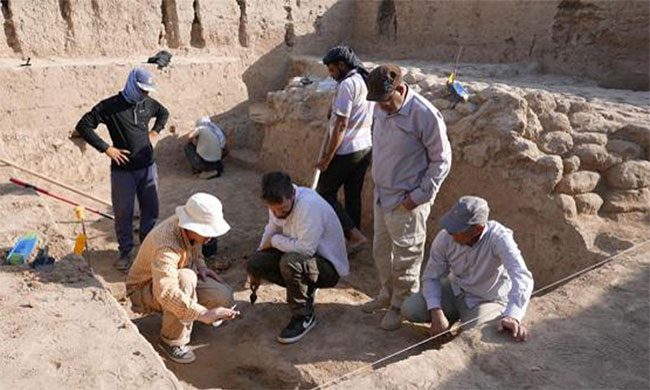Archaeologists have uncovered the remnants of a temple dedicated to the god Ningirsu of the ancient Sumerians in southeastern Iraq.
The long-forgotten temple, built of mud bricks, is located in the heart of the ancient city of Girsu, now known as Tell Telloh in Dhi Qar Province. It dates back approximately 4,500 years and was dedicated to the worship of Ningirsu, the thunder god of the Sumerians in the Mesopotamian region, as reported by Live Science on February 24.
“At Girsu, we have discovered and are still excavating one of the most significant sacred spaces in the entire ancient Mesopotamia,” emphasized Sebastien Rey, a leading archaeologist at the British Museum in London, in a statement.
The temple at Girsu, Iraq, was used for hosting feasts, parades, and animal sacrifice rituals dedicated to Ningirsu from 2950 to 2350 BCE, as reported by Live Science on March 30. The team unearthed over 300 cups, bowls, jars, and ceramic vessels, many of which were broken, along with a large quantity of animal bones. These were found inside or near a pit that was 2.5 meters deep.

Experts excavating the ancient temple in Girsu. (Photo: Ancient Origins).
One of the most impressive artifacts found by the team was a small bronze statue resembling a duck, with eyes made from the hard shell of an animal. This is likely an object used to worship Nanshe, the goddess associated with water, marshes, and waterfowl. Additionally, archaeologists also uncovered a fragment of a jar inscribed with text about Ningirsu.
Rey and Greenfield noted that the cups and glasses they found may have been used in religious feasts before being discarded into the pit. Meanwhile, the animal bones, which included sheep, cattle, deer, antelope, fish, goats, pigs, and birds, were remnants after being consumed or killed for sacrificial purposes.
A thick layer of ash covering the floor of the temple is likely evidence of fire rituals. The research team also found eight oval fragments filled with ash that could be remnants of lanterns or lamps placed beneath the floor.
Inscribed clay tablets discovered at Girsu in the late 19th and early 20th centuries describe religious ceremonies and parades that took place at the temple. According to these accounts, a festival honoring Ningirsu occurred twice a year and lasted for three to four days. During the ceremony, ancient people would parade from the center of Girsu, traversing the city territory to Gu’edena, located just outside Girsu, before returning to conclude at the original central area.
Girsu was once a bustling cultural center in Mesopotamia—a vast region situated between the Euphrates and Tigris rivers, encompassing parts of modern-day Iraq, eastern Syria, southeastern Turkey, western Iran, and Kuwait, and was home to some of the earliest civilizations. The Sumerians may be the oldest civilization in the world and were the first to establish religions and legal codes.
French archaeologist Ernest de Sarzec first discovered the ancient city of Girsu in 1877 and collected all the artifacts he could find, including a 4,000-year-old statue of the Sumerian king Gudea, who ruled the city at the end of the third millennium BCE. As a result, many believed there was nothing left to excavate. Political conflicts in the region also posed barriers for scientists attempting to access the site for further study. However, Rey has always believed that Girsu holds many secrets yet to be revealed.
“After World War II and many years of subsequent conflict in Iraq, the ancient city of Girsu was all but forgotten,” Rey stated. “Today, Girsu is perhaps one of the most important heritage sites in the world that very few people are aware of.”

A digital reconstruction illustrating what the Sumerian temple in Girsu may have looked like 4,500 years ago. (Photo: British Museum)
The new excavation project led by Rey has utilized remote sensing technology to detect structures buried beneath sand and sediment. They have also created digital elevation models to understand how the landscape has changed since the first excavations in the 19th century.
After five seasons of excavation, in addition to the new discovery of the temple dedicated to Ningirsu, Rey’s team has also found an enclosure, a ceremonial square, and a portion of the wall surrounding the religious complex, complete with an impressive gate.
Inside the temple, there was a sacred statue of Ningirsu, one of the most important deities of the Sumerians. The Sumerians believed that Ningirsu wielded power over thunder, storms, and floods, and represented agriculture, according to the British Museum.


















































